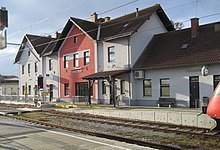Pannoniabahn
| Wulkaprodersdorf – Parndorf | |||||||||||||||||||||||||||||||||||||||||||||||||||||||||||||||||||||||||||||||||||||||||||||||||||||||||
|---|---|---|---|---|---|---|---|---|---|---|---|---|---|---|---|---|---|---|---|---|---|---|---|---|---|---|---|---|---|---|---|---|---|---|---|---|---|---|---|---|---|---|---|---|---|---|---|---|---|---|---|---|---|---|---|---|---|---|---|---|---|---|---|---|---|---|---|---|---|---|---|---|---|---|---|---|---|---|---|---|---|---|---|---|---|---|---|---|---|---|---|---|---|---|---|---|---|---|---|---|---|---|---|---|---|
| Course book route (ÖBB) : | 730 | ||||||||||||||||||||||||||||||||||||||||||||||||||||||||||||||||||||||||||||||||||||||||||||||||||||||||
| Route length: | 40.2 km | ||||||||||||||||||||||||||||||||||||||||||||||||||||||||||||||||||||||||||||||||||||||||||||||||||||||||
| Gauge : | 1435 mm ( standard gauge ) | ||||||||||||||||||||||||||||||||||||||||||||||||||||||||||||||||||||||||||||||||||||||||||||||||||||||||
| Power system : | 15 kV 16.7 Hz ~ Bf Wulkaprodersdorf: 25 kV 50 Hz ~ |
||||||||||||||||||||||||||||||||||||||||||||||||||||||||||||||||||||||||||||||||||||||||||||||||||||||||
| Maximum slope : | 13 ‰ | ||||||||||||||||||||||||||||||||||||||||||||||||||||||||||||||||||||||||||||||||||||||||||||||||||||||||
| Minimum radius : | 190 m | ||||||||||||||||||||||||||||||||||||||||||||||||||||||||||||||||||||||||||||||||||||||||||||||||||||||||
| Top speed: | 120 km / h | ||||||||||||||||||||||||||||||||||||||||||||||||||||||||||||||||||||||||||||||||||||||||||||||||||||||||
|
|||||||||||||||||||||||||||||||||||||||||||||||||||||||||||||||||||||||||||||||||||||||||||||||||||||||||
The Pannoniabahn , also known as the Leithagebirgsbahn , is the section of the historic railway connection from Sopron to Bratislava (ung. Pozsony ) between Wulkaprodersdorf and Parndorf Ort station.
history

This originally West Hungarian local railway was licensed as Sopron-Pozsonyi helyiérdekű vasút and opened on December 18, 1897. Between Sopron and Wulkaprodersdorf it used the route of the Raab-Oedenburg-Ebenfurter Eisenbahn , the northern section corresponds to today's branch line Parndorf-Bratislava of the Eastern Railway .
The route appeared several times, despite being served by the state capital Eisenstadt, in lists of railways at risk of being discontinued. The first modernization steps through the introduction of a regular timetable with coordinated connections at the end points from the 1990s as well as the introduction of express trains from Vienna via the Raaberbahn and Wulkaprodersdorf to Eisenstadt brought the hoped-for increase in passengers, which ultimately led to the decision to undertake comprehensive modernization and electrification.
The line from Neusiedl am See to Wulkaprodersdorf has been electrified since 2009, with the ÖBB electricity system (15 kV with 16.7 Hz) being used on the Neusiedl – Eisenstadt section, and the Raaberbahn (25 kV) system being used on the section from Eisenstadt to Wulkaprodersdorf with 50 Hz).
The Wiener Bogen was used for the first time when the Pannoniabahn was expanded . This special type of curve made it possible to increase the top speed of the route from 80 to 120 km / h without any significant straightening of the route. This resulted in travel time savings of around ten minutes.
route
The route runs along the foothills of the Leithagebirge in the Austrian state of Burgenland and connects the Burgenland capital Eisenstadt with the Austrian railway network. It runs from Wulkaprodersdorf along the Leithagebirge to Neusiedl am See .
vehicles
Since electrification , the Pannoniabahn has mainly been used by class 4124 railcars . Prior to electrification, diesel multiple units of the series 5047 of the ÖBB and Raaberbahn, as well as their predecessor series, were in use.
Timetable
Apart from the early morning, there is an hourly basic cycle with train crossing in Eisenstadt, but with a symmetry time that is four minutes before the usual time. In the afternoon rush hour, the train service from Bruck an der Leitha to Wulkaprodersdorf is compressed to approximately half an hour.
Flugelbahn to St. Margarethen-Rust
Starting from the Schützen am Gebirge station , a six-kilometer-long wing runway to the quarries in St. Margarethen was built as part of the main line , which was also opened on December 18, 1897. The junction can still be seen in the area, but interestingly, the railway was connected to the Schützen am Gebirge station from the north.
There was a train station in Oslip , which today is only reminiscent of the "Bahnstraße". At St. Margarethen, the street “Am alten Bahnhof”, which leads from St. Margarethen towards the quarries, is reminiscent of the railway line. The former railway systems can still be seen in the quarry.
Passenger, baggage, express and general cargo traffic was stopped on January 1, 1937 and resumed on November 1, 1943. In April 1945 the Wulka Bridge was blown up, which interrupted traffic until it was rebuilt in 1948. The final end came for passenger traffic on October 2, 1949. The line was operated for freight traffic until February 18, 1952 as a drag line. In 1953 it was finally dismantled and the properties sold.
Surname
After a competition, the railway line was christened the Pannoniabahn on June 22, 2010 . Before that, the route Neusiedl am See - Eisenstadt - Wulkaprodersdorf - Ebenfurth - Wr. Neustadt trades as Neusiedlerseebahn in the ÖBB timetable (timetable picture 730) . The origin and historical meaning of the name Leithagebirgsbahn , which is used in railway forums, is unclear.
Web links
Individual evidence
- ↑ The railway company was founded in 1897 under the name Sopron-Pozsonyi helyi érdekű vasút részvény társaság (German: Ödenburg-Preßburger Lokalbahn AG). On the common shares issued in May 1897 is the German name Sopron-Pozsonyer Localbahn-Actien-Gesellschaft , and the French name is Société anonyme du chemin de fer vicinal Oedenburg-Presbourg [sic], see facsimile of the 100 guilder common share .
- ↑ Dieter Geerkens: Securities of Austrian Railways , pages 188-189, bahnmedien.at, Vienna 2009
- ^ Court of Auditors report . In: oesterreich.orf.at , January 14, 2011, accessed on March 21, 2011.
- ↑ New name for the railway line: "Pannoniabahn" . In: burgenland.orf.at , June 22, 2010, accessed on March 21, 2011.
